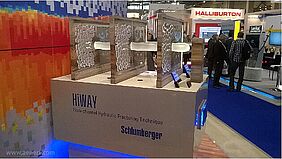Previously, we published articles concerning the problems of high costs of equipment repair and replacement in directional drilling technology (18.11.2022), and equipment and procedures for well deflecting wellbores during the drilling process and correction of such deflection (27.11.2022). Here we will analyse patent documents related to solving environmental problems arising during directional drilling.
In recent years, environmental protection issues have become more and more acute in the oil and gas industry. Compared to traditional drilling methods, directional drilling has smaller environmental footprint due to smaller construction area and reduced impact on the surroundings. However, the number of risks involved in the process remains high. They may be associated with violations in the integrity of well, which may lead to leaks of harmful substances into the formation, or disruptions in the boundaries of existing water reservoirs during drilling, which may damage the ecosystem or contaminate drinking water resources. Wellbore formation process itself may also involve environmentally harmful substances that can impair the ecology of the reservoir. Procedures for the remediation of contaminated areas or water reservoirs can, in turn, be associated with high costs that can worsen the profitability of oil and gas recovery. Therefore, engineering departments of hydrocarbon producing companies pay considerable attention to ensuring environmental safety and preventing adverse ecological impact in the course of hydrocarbon production involving the directional drilling technology.
Below we provide a brief analysis of patents and patent applications disclosing inventions that to one degree or another are aimed at solving this problem. Almost 2300 patent documents published in the 20-year period between 2002 and 2021 were collected for the present analysis in accordance with the Advanced Energy Technologies methodology. The collected patent documents have been published in 31 patent offices around the world by 614 applicants from 25 countries.
In the entire pool of inventions related to directional drilling, a substantial number of patent documents concern the problem of maintaining ecological balance. This is true for both patents granted between 2002 and 2021, and recently published applications.
Directional drilling. Ecological balance. Relationship of number of applications to total number of documents by year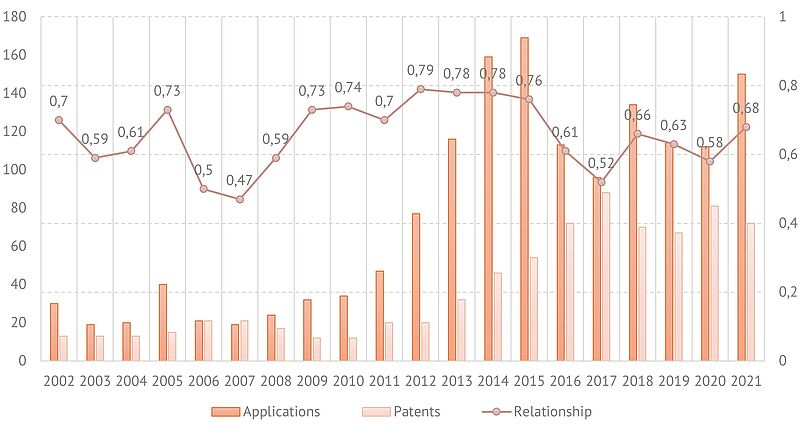
The chart above shows that after the peak in 2014-2015, the number of annually registered patent applications has moderately declined, but was still high in the last years. The number of patents reached its highest value in 2017 and was high until the end of the period of time under consideration. In 2021 more than 70% of patent applications were start documents not belonging to any previously formed patent family. Also, this subject also demonstrates the growth in annual appearance of new applicants and new IPC subgroups assigned to the patent documents. All this indicates a steady increase in the interest of inventors in the development of this industry and its expansion through the introduction of innovative technical solutions.
More than 30% of patents published between 2002 and 2021 were granted by the USPTO (US) patent office. CNIPA (CN) and CIPO (CA) each granted more than 10% of the collected patents. In terms of the number of patent applications registered in the past 5 years, CNIPA Patent Office (CN) was the leader with almost 50% of all applications.
Directional drilling. Ecological balance. Breakdown of inventions by patent offices. Patents, 2002-2021 (left); Applications, 2017-2021 (right)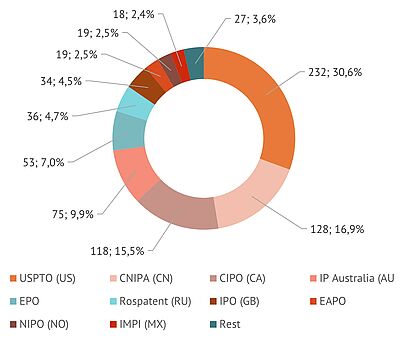
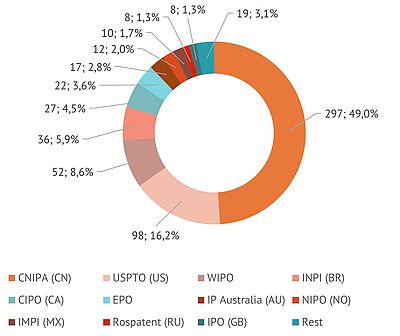
Similar picture can be seen in the distribution of applicants by the countries of residence. As of patents published in the past 20 years, almost 60% of all applicants were from the USA, while in the case of patent applications registered between 2017 and 2021, Chinese applicants were in the lead with more than 45% share. Applicants from Canada, the United Kingdom, the Netherlands, and Saudi Arabia also demonstrated high activity in the collection of 20-year patents.
Below is the list of 10 leading Applicants for the patents published between 2002 and 2021:
Directional drilling. Ecological balance. Top applicants. Patents, 2002-2021
| Status | Country | Name | Average rating | Total 2002-2021 |
|---|---|---|---|---|
| Company | US | Halliburton Energy Services, Inc. | 18.3 | 188 |
| Company | US | Baker Hughes Incorporated | 18.6 | 60 |
| Company | US | Schlumberger Technology Corporation | 16.2 | 29 |
| Company | GB | Cleansorb Limited | 16.8 | 16 |
| Company | DK | Welltec A/S | 16.4 | 14 |
| Company | US | ExxonMobil Upstream Research Company | 17.8 | 12 |
| Person | US | Nevin Donald | 13.7 | 12 |
| Company | CN | CNPC China National Petroleum Corporation | 15.1 | 11 |
| Company | US | M-I LLC | 16.3 | 11 |
| Company | VG | Schlumberger Holdings Limited | 18.9 | 11 |
The leader in terms of Market involvement ratio was Halliburton Energy Services, Inc. with a share of almost 25% (Market involvement ratio = volume ratio multiplied by ownership ratio, where Volume ratio - share of applicant documents in total number of documents, Ownership ratio - applicant's participation share in total number of documents). It was followed by Baker Hughes Incorporated with a share of 8%. In the collection of patent applications published between 2017 and 2021, Halliburton Energy Services Inc. retained its leading position with a share exceeding 10%.
Directional drilling. Ecological balance. Top applicants. Applications, 2017-2021
| Status | Country | Name | Average rating | Total 2017-2021 |
|---|---|---|---|---|
| Company | US | Halliburton Energy Services, Inc. | 13.6 | 65 |
| Company | US | Schlumberger Technology Corporation | 13.9 | 34 |
| Company | SA | Saudi Arabian Oil Company | 12.2 | 26 |
| Company | NL | Schlumberger Technology B.V. | 12.6 | 25 |
| Company | CN | CNPC China National Petroleum Corporation | 12.2 | 19 |
| Company | CN | Sinopec China Petroleum & Chemical Corporation | 13.8 | 18 |
| Organization | CN | CCTEG Xi’an Research Institute | 9 | 16 |
| Company | CA | Schlumberger Canada Limited | 12.8 | 16 |
| Company | FR | Services Petroliers Schlumberger | 12.8 | 16 |
| Organization | CN | UPC China University of Petroleum | 12.3 | 15 |
Along with the Ecological balance problem, Low efficiency / Main processes, High OPEX / Operation and consumables, and High OPEX / Repair and replacement were mentioned the most in the collected patent documents. Methods were mainly chosen as the types of technical solutions by the authors, although devices and compositions were encountered in many documents as well. The most popular IPC subgroups among those assigned to the patents collected for this review were E21B43/26 (by forming crevices or fractures), E21B7/04 (Directional drilling), E21B43/16 (Enhanced recovery methods for obtaining hydrocarbons), E21B7/06 (Deflecting the direction of boreholes), E21B41/00 (Equipment or details not covered by groups E21B 15/00-E21B 40/00), and E21B43/24 (using heat, e.g. steam injection).
In the pool of documents collected for the present analysis, the largest patent families contain 28, 27, and 26 patent documents and are represented by core documents US9127533B2, US7571777B2, and US5868201A, respectively (Core document is a base document for which a complete description of the invention is available in generally-accessible patent databases):
Well completion / P: US9127533B2 / IPC: E21B23/00, E21B43/10, E21B43/26, E21B33/128, E21B17/00 / Hallundbae buttedk Jorgen, Hazel Paul / WELLTEC A/S / Appl. date: 16/12/2011; Publ. date: 08/09/2015 / United States Patent and Trademark Office / Core document: US9127533B2 / Technology categories: DD / Technology elements: DR / Problems: EB, HCEI, HOOC, LEMP / Technical solution types: D, M / Claims: 17 / Rating: 17
Method and apparatus for a monodiameter wellbore, monodiameter casing, monobore, and/or monowell / P: US7571777B2 / IPC: E21B47/12, E21B7/26 / Wylie Glenda, Zamora Frank, Murali Beegamudre N, Terry James B, Brothers Lance Everett, Palmer Anthony Vann, Reddy Baireddy R, Eoff Larry S, Weaver Jimmie D, Wilson John M, Berryhill Denise, Fitsgerald Russell M, Culotta Anne M, Rao M Vikram, Boulton Roger, Chen Chen-Kang David, Gaynor Thomas M, Hardin John, Gleitman Dan, Walker Colin / Halliburton Energy Services, Inc. / Appl. date: 10/12/2007; Publ. date: 11/08/2009 / United States Patent and Trademark Office / Core document: US7571777B2 / Technology categories: DD / Technology elements: DR / Problems: EB, EGWC, HOOC, HORR, LEG, UP / Technical solution types: M / Claims: 11 / Rating: 20
Computer controlled downhole tools for production well control / P: US5868201A / IPC: E21B23/00, E21B49/00, E21B33/10, E21B33/12, E21B34/06, E21B23/03, E21B17/02, E21B43/14, E21B34/00, E21B47/01, E21B47/00, E21B43/00, E21B34/10, E21B34/16, E21B41/00, E21B33/127, E21B49/08, E21B47/06, E21B49/08 / Bussear Terry R, Weightman Bruce, Aeschbacher Jr William E, Krejci Michael F, Rothers David, Jones Kevin / Baker Hughes Incorporated / Appl. date: 22/08/1997; Publ. date: 09/02/1999 / United States Patent and Trademark Office / Core document: US5868201A / Technology categories: DD / Technology elements: DR / Problems: EB, HOOC, LEMP / Technical solution types: D / Claims: 7 / Rating: n/a
Below are several examples of patents having the highest patent rating calculated in accordance with the Advanced Energy Technologies methodology from the pool of patent documents aimed at solving the problems of maintaining ecological balance in horizontal and directional drilling:
Directional drilling. Ecological balance. Prominent patent documents by rating, 2002-2021:
用于传输处理流体的系统和方法 (en: System and method for delivering treatment fluid) / P: CN104271877B / IPC: E21B43/26 / SHAMPINE ROD, LEUGEMORS EDWARD, LESKO TIMOTHY M / PRAD RES & DEV LTD / Appl. date: 08/03/2013; Publ. date: 07/01/2015 / National Intellectual Property Administration / Core document: US20130233542A1 / Technology categories: DD, HF, TG / Technology elements: FEM, FWF / Problems: EB, HCEI, HCEP, HOOC, LEMP / Technical solution types: C, D, M / Claims: 40 / Rating: 22
Closed-loop drawdown apparatus and method for in-situ analysis of formation fluids / P: AU2001082928C / IPC: E21B49/00, E21B49/10, E21B47/06, G01V11/00 / Krueger Volker, Meister Matthias, Jones Stanley C, Lee Jaedong, Michaels John M / Baker Hughes Incorporated / Appl. date: 20/07/2001; Publ. date: 10/02/2005 / IP Australia / Core document: US6609568B2 / Technology categories: DD / Technology elements: EX / Problems: EB, LEE, LEMP / Technical solution types: D, M / Claims: 29 / Rating: 21
DRAWDOWN APPARATUS AND METHOD FOR IN-SITU ANALYSIS OF FORMATION FLUIDS / P: CA2385376C / IPC: E21B49/08, E21B49/00, E21B49/10 / KRUEGER VOLKER, MEISTER MATTHIAS, MICHAELS JOHN M, LEE JAEDONG, JONES STANLEY C / BAKER HUGHES INCORPORATED / Appl. date: 20/07/2001; Publ. date: 05/04/2005 / Canadian Intellectual Property Office / Core document: US6609568B2 / Technology categories: DD / Technology elements: EX / Problems: EB, LEE, LEMP / Technical solution types: D, M / Claims: 29 / Rating: 21
Invert emulsion drilling fluids comprising quaternary ammonium emulsifiers and argillaceous solids and methods of drilling boreholes / P: US7939470B1 / IPC: C09K8/36, E21B21/00, B01F3/08 / Wagle Vikrant Bhavanishankar, Maghrabi Shadaab Syed / Halliburton Energy Services Inc. / Appl. date: 27/03/2010; Publ. date: 10/05/2011 / United States Patent and Trademark Office / Core document: EA24120B1 / Technology categories: DD / Technology elements: DR / Problems: EB, HOOC / Technical solution types: C / Claims: 20 / Rating: 21
METHOD AND APPARATUS FOR CONTINUOUSLY TESTING A WELL / P: BR9819B1 / IPC: E21B49/08 / BJORN LANGSETH, CHRISTOPHER W SPIERS, DINESH R PATEL / SCHLUMBERGER TECHNOLOGY CORPORATION / Appl. date: 19/04/2000; Publ. date: 22/02/2012 / National Institute of Industrial Property / Core document: US6352110B1 / Technology categories: DD / Technology elements: DR / Problems: EB, UP / Technical solution types: M / Claims: 122 / Rating: 21
The following are several examples of patented solutions aimed at solving ecology-related problems in directional drilling:
- CA2993934C – the authors propose an environmentally friendly well cementing materials including an aggregate, urea, a calcium ion source, a calcium carbonate producing agent, a microbe, a nutrient for the microbe, an enzyme, and an enzyme stabilizer;
- US11073011B2 – prevention of environmental risks by providing a wellbore tubular integrity evaluation system;
- US9410376B2 – a drilling system is aimed to maintain the integrity of geological formations, such as water-bearing reservoirs, by providing remotely-controlled operation in various modes.
In patent CA2993934C, Baker Hughes Incorporated (US) proposes a well cementing composition. The proposed settable slurry includes an aqueous carrier, an aggregate (sand, gravel, crushed stone, slag, recycled concrete, silica, grass spheres, limestone, feldspar, or their combination), urea, a calcium ion source (calcium chloride, calcium bromide, calcium nitrate, or their combination), a calcium carbonate producing agent, a microbe (Sporosarcina pasteurii, or others specified in the claims) and a nutrient for the microbe, an enzyme (urease, amidase, carbonic anhydrase, glutamade dehydrogenase, glutamate synthase, or their combination), an enzyme stabilizer (casein, albumin, powdered milk, whey protein, bovine serum albumin, or their combination). Various combinations of the components described in the document are also allowed. The settable composition includes solids in an amount of about 50 wt. % to about 95 wt. % of the total weight of the settable slurry. Additionally, it can include "…an additive comprising a reinforcing agent, a self-healing additive, a fluid loss control agent, a weighting agent, an extender, a foaming agent, a dispersant, a thixotropic agent, a bridging agent or lost circulation material, a clay stabilizer, or a combination comprising at least one of the foregoing".
The authors highlight the need to create environmentally friendly well cementing materials. It is mentioned that the material can be used for horizontal, lateral or deviated wells. The patent family of this document consists of 11 documents published in CA, WO, US, AR, BR, CO, EP, MX between 2017 and 2021.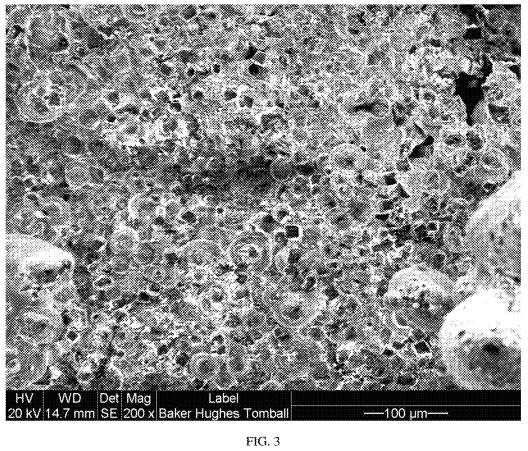
Image from: US10125303B2
Patent US11073011B2 published by Halliburton Energy Services, Inc. (US) describes a method and a system for evaluating the integrity of a tubular located in a wellbore. According to the method, wellbore operating parameters are measured by means of a testing device and a fiber optic sensing system that includes an interrogator and a fiber optic cable and is capable of measuring pressure, temperature, flow rate, pH, acoustic energy, vibrations, or their combination. The testing device is introduced into the tubular to perform multiple measurements of its characteristics, after which, based on each measurement, a tubular integrity log is created. The tubular integrity logs and the operating parameters are used to perform the integrity analysis the of the tubular, which is used to determine if the tubular remains within the pre-set parameter limitations and to determine the duration of integrity. The operating parameters include parameters outside the tubular and a property of the fluid inside the tubular, such as temperature, pressure, flow rate, density, composition, pH, or their combination. The analysis calculates the rates of change in the tubular characteristics, such as corrosion, roughness, pits on the tubular, deformation, scales in the tubular, flow restrictions within the tubular, wall thickness, inner diameter, or their combination. The claims of the document also stipulate other parameters and options for the operation of the system. The authors point out the existence of serious risks to the environment in cases of untimely diagnostics of the integrity violations of the tubular.
The patent is part of a family of 9 patent documents published in 2019-2021 in WO, AU, CA, US, BR, CO.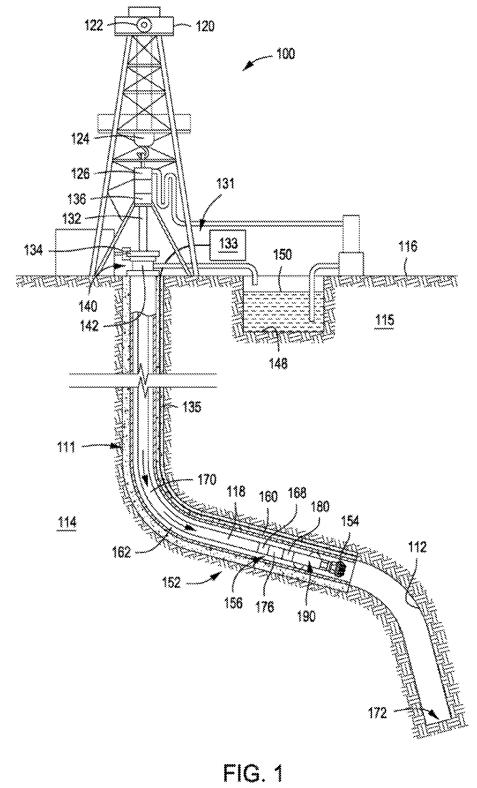
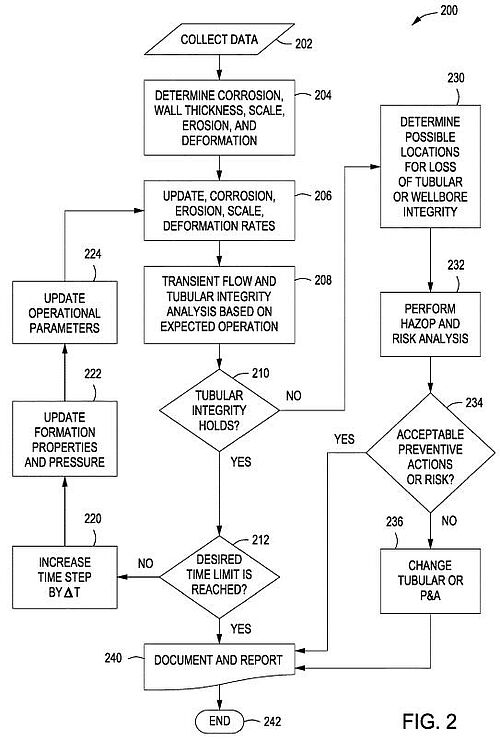
Images from: US11073011B2
US9410376B2 published by RAMAX LLC (US) discloses a drilling system for enhanced hydrocarbon production.
The drilling system comprises a drill string through which drilling fluid flows, and a drill bit connected to the drill string and having two or more modes of operation. The drill bit includes a valve assembly and a housing containing the drill and two holes connected to two corresponding grooves and providing the first and second modes of operation. The housing also contains a spool with an axial bore, and the drilling fluid is fed to the spool from one side. The spool has the ability to move between the first and second positions, which provide different drilling fluid pressures for the first (about 40-50 kpsi) or second (about 30-40 kpsi) modes of operation, respectively. Locking of the spool in different positions is provided by a detent assembly comprising a spring and a locking pin. The locking pin is biased against a first or a second notch of the spool, depending on the position. The front surface of the drill bit body includes a swivel head with a cutting head (laser, mechanical drill bit, fluid jet) and has the ability to rotate at an angle relative to the longitudinal axis of the body. A side panel cutting head is positioned on the circumferential surface of the drill head body.
The authors of the invention point out the possibility to remotely control operating modes by changing the fluid pressure, and to maintain the integrity and stability of geological formations, including water-bearing reservoirs, when drilling oil and gas wells.
The family of the patent includes 5 documents published in the US and WO between 2014 and 2016.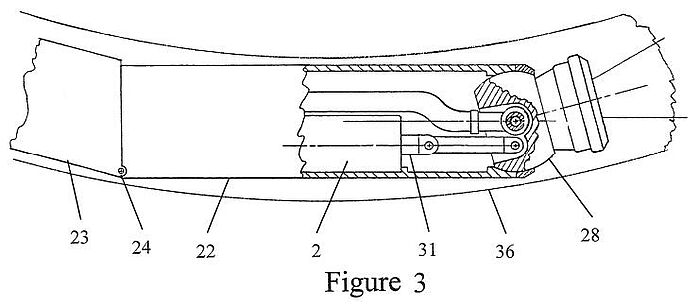

Images from: US9410376B2
More detailed information about inventions in the field of directional drilling, and patent research methodology can be found on aenert.com and in DIRECTIONAL DRILLING. Patent Database. August 2022.
